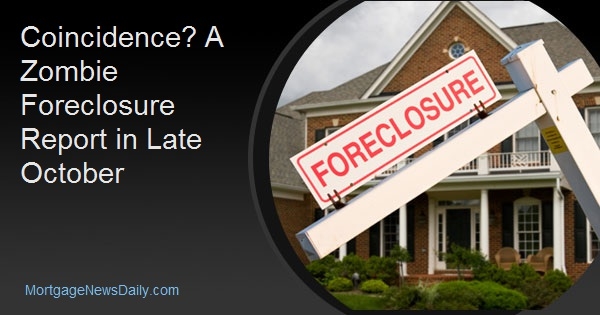While they are talking apples and oranges, both the U.S. Census Bureau and ATTOM Data Solutions each took a recent look at residential vacancies. The Census Bureau's quarterly report on Residential Vacancies and Homeownership noted a decline in the incidence of rental property vacancies and a stable situation among owned properties while ATTOM was concerned primarily with what they call "zombie" foreclosures, homes that fall vacant during the foreclosure process.
The Census Bureau puts the vacancy rate for rental housing at 7.1 percent in the third quarter of this year, down from 7.5 percent last year, while the homeowner vacancy rate, at 1.6 percent was identical year-over-year. The report estimates a total of 138.6 million housing units nationwide, 121.354 million or 87.6 percent of which are occupied. Of the 121.4 million occupied units, 78.1 million are owner units and 43.3 million are rentals. The number of residential units nationwide increased by 1.1 million between the third quarter of 2017 and the most recent period.
Both homeowner and rental vacancies were highest in the South at 1.7 percent and 8.7 percent respectively and lowest in the West at 1.4 percent and 5.1 percent. Rental vacancies were highest outside of metropolitan statistical areas at 9.2 percent.
The Census Bureau puts the median asking price for a vacant rental unit during the third quarter at $1,003. The median list price for a vacant for-sale unit was $206,400.
ATTOM is in fairly close agreement with the Census Bureau, putting the number of vacant single family homes and condos at 1,447,906 or 1.52 percent of all homes nationwide. The rate at the end of the third quarter of 2017 was 1.58 percent. The company also found there were 10,291 vacant "zombie" foreclosure homes nationwide. This is 3.38 percent of all homes actively in the foreclosure process and down from a rate of 4.18 percent a year earlier, and a property count of 14,312.
This is of interest primarily because, as Daren Blomquist, ATTOM senior vice president says, it is one-quarter the number of such zombies that ATTOM, then known as RealtyTrac found in 2013 when it first started tracking the issue. As recently as January 2015, the percentage of homes in foreclosure that had fallen vacant had increased to around 25 percent, because, as Blomquist said then, "...they tend to be the problem cases still stuck in the pipeline. Additionally, the states where overall foreclosure activity has been increasing over the past year - counter to the national trend - tend to be states with a longer foreclosure process more susceptible to the zombie problem."
Now Blomquist notes that "Policy solutions such as land banks designed to mitigate the ripple effects of vacant properties on neighborhoods and cities have had a substantial impact, and a booming housing market in many areas of the country is lifting all boats. There are still high concentrations of zombie homes and other vacant homes in some local markets and submarkets, but those high concentrations are becoming fewer and farther between."
States with the highest share of vacant homes were Tennessee (2.65 percent), Kansas (2.50 percent), Oklahoma (2.49 percent), Mississippi (2.47 percent), and Indiana (2.45 percent). Interestingly, none of these are the states where foreclosure timelines were running to four and five years just a few years ago. Among the 153 metropolitan statistical areas analyzed in the report, those with the highest share of vacant homes were Flint, Michigan (6.99 percent); Youngstown, Ohio (3.80 percent); Beaumont-Port Arthur, Texas (3.71 percent); Myrtle Beach, South Carolina (3.70 percent); and Mobile, Alabama (3.69 percent).







